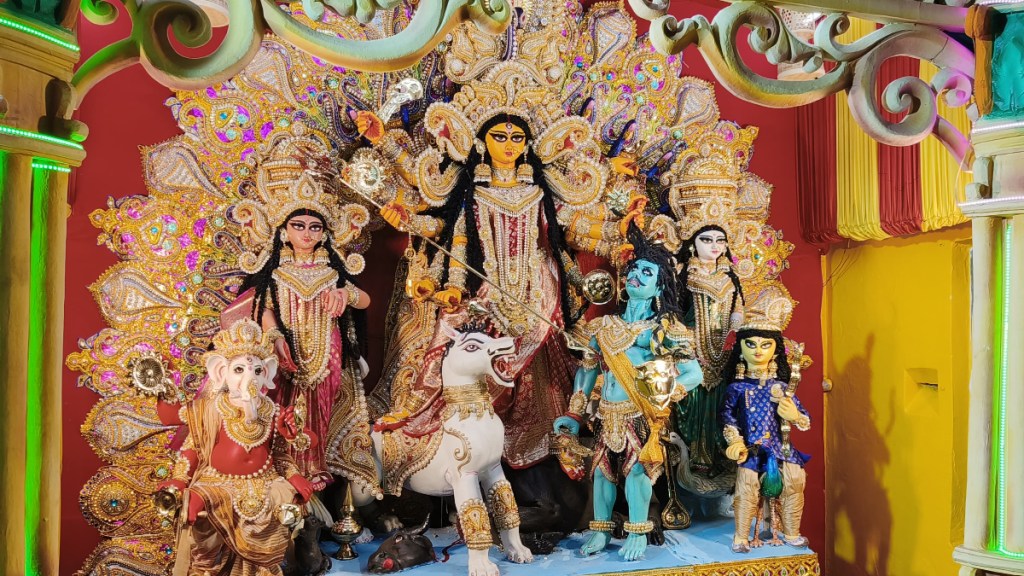Shardiya Navratri 2024 Day 1: As the vibrant festival of Shardiya Navratri dawns, devotees across India are prepared to honor the divine feminine energy embodied by Goddess Durga. The first day is dedicated to Maa Shailputri, the mountain goddess, whose worship marks the beginning of the sacred nine-nights of celebration. Revered as the daughter of the Himalayas, Maa Shailputri represents the essence of strength, purity, and compassion. Her blessings are believed to grant devotees the fulfillment of their deepest desires and liberation from suffering.
Navratri 2024 Day 1, Maa Shailputri: Significance
Maa Shailputri is depicted as a serene and graceful figure, embodying calmness and compassion. In her right hand, she wields a trident, while her left hand gracefully holds a lotus. She rides upon Nandi, the sacred bull, symbolizing her connection to Lord Shiva. As a goddess who undertakes intense penance, Maa Shailputri serves as a protector of all living beings. Her worship on the first day of Navratri is said to relieve devotees from hardships, offering them guidance and support during challenging times. Moreover, she aids in awakening the root chakra (Muladhara), the energy center that provides stability and security in life.
The worship of Maa Shailputri on the first day of Navratri holds great significance. The term “Shail,” meaning stone, signifies steadfastness. The color white is especially important, and offerings of white flowers, garments, and sweets are encouraged. Devotees believe that worshipping Maa Shailputri can bless unmarried girls with suitable husbands and ensure an abundance of wealth.
Navratri 2024 Day 1: Color of the day
The first day of Navratri is celebrated with the vibrant color yellow, symbolizing joy, optimism, and new beginnings. This color is associated with Maa Shailputri, the first form of Goddess Durga, who embodies strength and purity. Devotees wear yellow to invoke positivity and seek blessings for fresh starts in their lives. The bright hue reflects the essence of the season, encouraging feelings of happiness and warmth. As worshippers come together in celebration, the color yellow not only enhances the festive spirit but also serves as a reminder to embrace hope and positivity as they embark on this sacred journey.
Navratri 2024 Day 1: Puja Timings, Vidhi and Rituals
On this auspicious day, the ritual of ‘kalash sthapana’ is done. This involves invoking the presence of Goddess Durga in a copper or clay pot, which will be kept at the worship site for nine days. Essential items for this ritual include holy water (Ganga jal), a coconut, red cloth, sacred thread (moli), roli, sandalwood, betel leaves, areca nut, incense sticks, a ghee lamp, fresh fruits, a flower garland, and clean rice. For this year’s Shardiya Navratri, which begins on October 3, the most auspicious times for kalash sthapana are from 4:09 to 5:07 AM in temples and from 9:40 to 11:50 AM in homes and pandals.
According to the Devi Bhagavata Purana, worshiping Maa Shailputri begins early in the morning. Devotees rise during Brahma Muhurta, bathe, and don clean clothes. After purifying a raised platform with Ganga jal, they place the idol or picture of Maa Durga upon it. The kalash is then established with proper rituals alongside family members.
Once the kalash is in place, devotees chant meditation mantras for Maa Shailputri and take vows to observe the Navratri fast. The worship involves the Shodashopachara method, which includes invoking all rivers, holy sites, and cardinal directions. Offerings of kumkum and flowers in white, yellow, or red are made, alongside lighting incense and lamps, including five ghee lamps. The ritual culminates with the aarti for Maa Shailputri.
Devotees may also recite sacred texts such as the Durga Chalisa, Durga Stuti, or Durga Saptashati, engaging in family prayers and concluding with bhog (food offerings) to the goddess. Evening rituals include another round of aarti and continued meditation.
Navratri 2024 Day 1: Vrat Katha/Aarti
The tale of Maa Shailputri is intricately linked to the strained relationship between Goddess Sati and her father, Prajapati Daksha. When Daksha organized a yajna but deliberately excluded Sati and Lord Shiva, Sati’s eagerness to attend, led to a tragic turn of events. Despite Shiva’s concerns, Sati attended the yajna, where she faced ridicule and disrespect. Deeply hurt by her father’s actions, Sati self-immolated in despair. Enraged, Shiva destroyed Daksha’s yajna, and in her next birth, Sati reincarnated as Shailputri, the daughter of the king of the mountains. Once again, she married Shiva, symbolizing the eternal bond between them.
It is believed that worshipping Maa Shailputri fulfills all wishes and awakens the root chakra, bringing stability and harmony into the lives of devotees. As the festivities of Navratri unfold, may the blessings of Maa Shailputri illuminate your path, empowering you to embrace strength, purity, and compassion.








